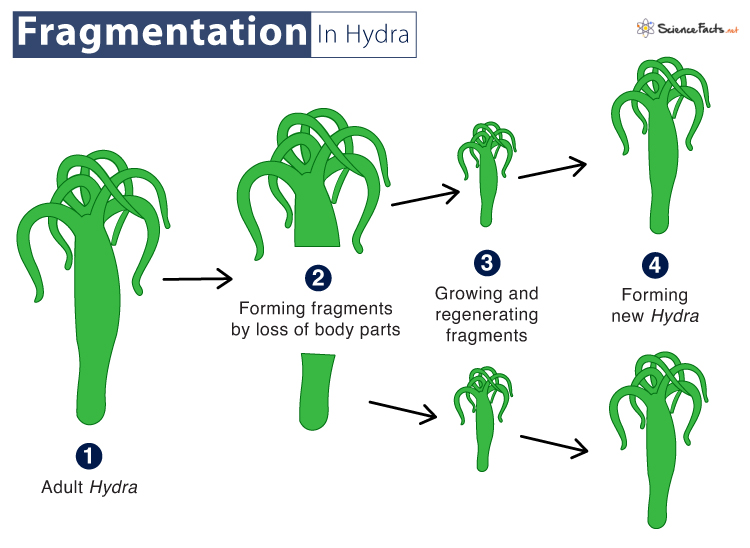Fragmentation
Fragmentation is a type of asexual reproduction in some multicellular organisms. As the name suggests, the parent body is split into pieces. Each piece develops into a mature, complete individual identical to its parent.
Fragmentation is found to occur in fungi such as yeasts and mushrooms. Plants such as ferns, mosses, and cyanobacteria also reproduce by fragmentation. In animals, sea stars are the most common example, although annelid worms, sponges, and flatworms also reproduce by this method.
Steps of Fragmentation
All organisms that reproduce through fragmentation follow the three elementary stages. They are:
- Step 1: Formation of fragments by removal of body parts
- Step 2: Growth and regeneration of fragments
- Step 3: Conversion of fragments into developed individuals
Fragmentation in Fungi and Algae
This method of growth and reproduction is most common in lower organisms such as algae and fungi. Molds, yeasts, and mushrooms are some common fungi where reproduction occurs through fragmentation.
Here, unique structures called hyphae take part in the process. They are the filamentous branches from which the mycelium of the fungi is formed. Before splitting, the hyphae grow on the fungi, from which they derive nutrients. Once mature to feed and reproduce, the hyphae detach from the parent body and start living independently.
Certain algae, such as filamentous-shaped Spirogyra, reproduce by forming separate fragments which develop into new individuals.
Fragmentation in Plants
In plants, fragmentation is a typical process of vegetative reproduction. It occurs by developing a new root and shoot system through the dispersion of rhizomes or stolon from the old plants. Thus, once detached from the parent plant colony, it starts developing on its own, giving rise to a new plant.
There are also some other forms of fragmentation in plants. Woody plants, like willows, shed twigs, which later grow into a new plant. This process of fragmentation is called cladoptosis. Again plants such as Kalanchoe daigremontiana develop adventitious plantlets on their leaves, which drop off and form independent plants.
Fragmentation is also observed in non-vascular plants such as liverworts and mosses. Small pieces of their body, such as stems or leaves, are scattered by the wind, water, or animals. On getting a suitable growth environment, they develop into a new plant.
Fragmentation is also used to propagate plants artificially in different ways, such as layering, cuttings, grafting, and micropropagation of storage organs, such as bulbs, corms, tubers, and rhizomes.
Fragmentation in Animals
It is natural in corals. Different annelid species and flatworms rely on fragmentation for their reproduction. Montipora, Acropora, and Pocillopora are some examples of such corals. Some methods of fragmentation in them are paratomy and architomy. In paratomy, the organism will split at a certain point, and the fragments develop their tissues and organs. However, in architomy, the organism splits into various fragments, which develop into mature individuals.
Most sea anemones also reproduce through fragmentation through longitudinal fission, where the parent’s body divides longitudinally into two halves forming two same-sized anemones. There is another method called basal laceration, where small parts of the parent split from the base to form new anemones.
In echinoderms, the process is known as fissiparity. Fragmentation is also common in hydra, starfish, and Planaria.
Advantages of Fragmentation
The process of fragmentation is of great biological importance. Some important ones are listed below:
- Shorter generation time and thus organisms grow and develop rapidly compared to those that reproduce through sexual means
- Forms large number of offspring as the chain of reproduction continues from one individual to two and from two to four, and so on
- Occur with the help of a single parent and thus can occur easily compared to sexual modes of reproduction where there is a need for a partner (both male and female gametes).
- Requires less energy expenditure compared to sexual modes of reproduction through the formation of gametes
- Involve in specific cellular processes, DNA fragmentation that occurs during DNA cloning and cell fragmentation, the final step of apoptosis
Disadvantages of Fragmentation
Although there are many advantages of fragmentation in nature, it also has some drawbacks. They are:
- It stops genetic diversity (variation). By fragmentation, all organisms will look the same, and the traits they carry will be a copy of their parent.
- It increases the chance of extinction of the species. As there is no genetic variation, if a disease is inherited, all the organisms are likely to get affected equally. Also, suppose a trait is not favorable for the environment. Then, each individual will suffer equally and is less likely to be selected by nature.
- It leads to overpopulation, causing scarcity of food and thus creating a struggle for space and existence within the organisms of the same species.
Fragmentation and Regeneration
Both the terms are often used simultaneously while describing asexual reproduction, although they are entirely different. Fragmentation refers to breaking the parent body into smaller fragments that can grow into separate individuals. In contrast, regeneration signifies the regrowth of particular body parts that are lost. Thus fragmentation can give rise to an entirely new individual, whereas regeneration can form a new organ.
Most organisms on Earth are capable of regeneration, whereas only a few organisms are capable of fragmentation. Regeneration is frequent in lizards and octopuses.
-
References
Article was last reviewed on Friday, November 18, 2022




